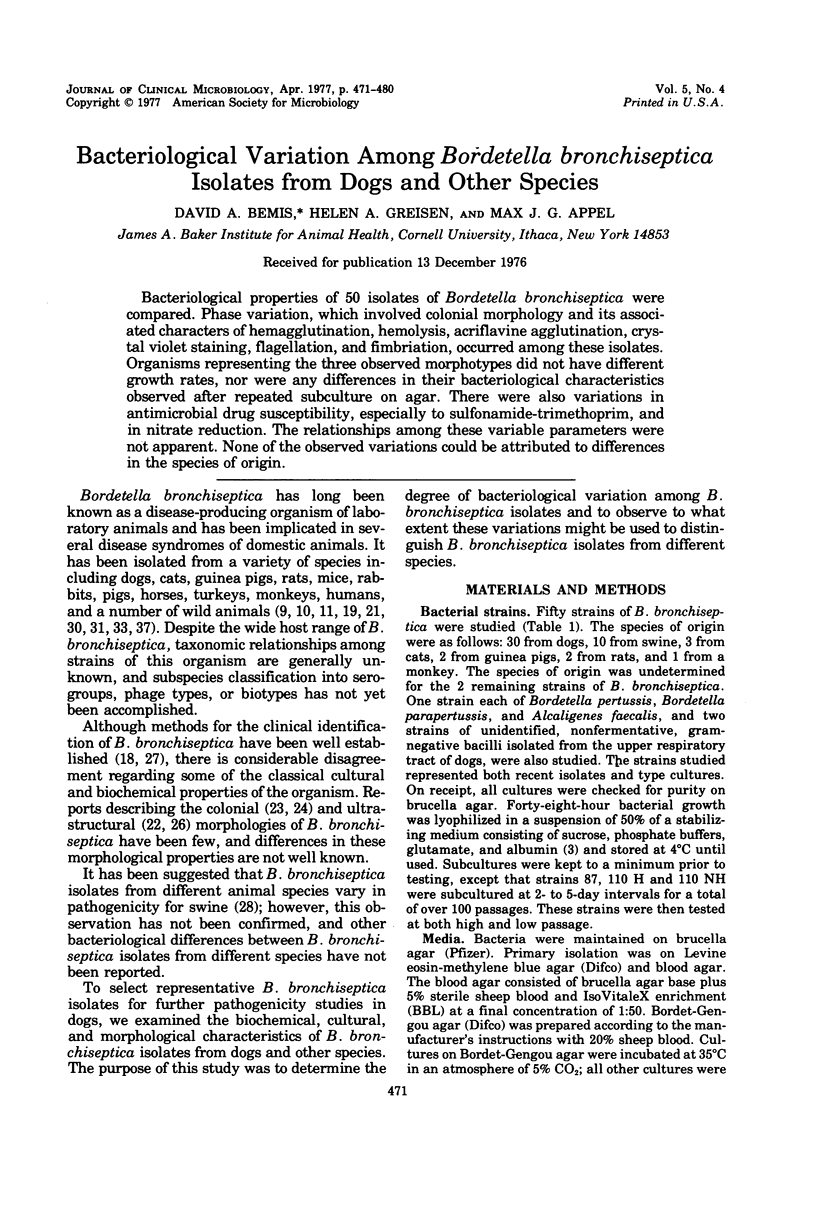Bacteriological variation among Bordetella bronchiseptica isolates from dogs and other species (original) (raw)
Abstract
Bacteriological properties of 50 isolates of Bordetella bronchiseptica were compared. Phase variation, which involved colonial morphology and its associated characters of hemagglutination, hemolysis, acriflavine agglutination; crystal violet staining, flagellation, and fimbriation, occurred among these isolates. Organisms representing the three observed morphotypes did not have different growth rates, nor were any differences in their bacteriological characteristics observed after repeated subculture on agar. There were also variations in antimicrobial drug susceptibility, especially to sulfonamide-trimethoprim, and in nitrate reduction. The relationships among these variable parameters were not apparent. None of the observed variations could be attributed to differences in the species of origin.

Images in this article
Selected References
These references are in PubMed. This may not be the complete list of references from this article.
- BOVARNICK M. R., MILLER J. C., SNYDER J. C. The influence of certain salts, amino acids, sugars, and proteins on the stability of rickettsiae. J Bacteriol. 1950 Apr;59(4):509–522. doi: 10.1128/jb.59.4.509-522.1950. [DOI] [PMC free article] [PubMed] [Google Scholar]
- Bauer A. W., Kirby W. M., Sherris J. C., Turck M. Antibiotic susceptibility testing by a standardized single disk method. Am J Clin Pathol. 1966 Apr;45(4):493–496. [PubMed] [Google Scholar]
- Bovre K., Froholm L. O. Variation of colony morphology reflecting fimbriation in Moraxella bovis and two reference strains of M. nonliquefaciens. Acta Pathol Microbiol Scand B Microbiol Immunol. 1972;80(5):629–640. [PubMed] [Google Scholar]
- Brinton C. C., Jr The structure, function, synthesis and genetic control of bacterial pili and a molecular model for DNA and RNA transport in gram negative bacteria. Trans N Y Acad Sci. 1965 Jun;27(8):1003–1054. doi: 10.1111/j.2164-0947.1965.tb02342.x. [DOI] [PubMed] [Google Scholar]
- Carmichael L. E. Canine brucellosis: isolation, diagnosis, transmission. Proc Annu Meet U S Anim Health Assoc. 1967;71:517–527. [PubMed] [Google Scholar]
- DUGUID J. P., SMITH I. W., DEMPSTER G., EDMUNDS P. N. Non-flagellar filamentous appendages (fimbriae) and haemagglutinating activity in Bacterium coli. J Pathol Bacteriol. 1955 Oct;70(2):335–348. doi: 10.1002/path.1700700210. [DOI] [PubMed] [Google Scholar]
- Filion R., Cloutier S., Vrancken E. R., Bernier G. Infection respiratoire du dindonneau causée par un microbe apparenté au Bordetella bronchiseptica. Can J Comp Med Vet Sci. 1967 May;31(5):129–134. [PMC free article] [PubMed] [Google Scholar]
- Fisk S. K., Soave O. A. Bordetella bronchiseptica in laboratory cats from central California. Lab Anim Sci. 1973 Feb;23(1):33–35. [PubMed] [Google Scholar]
- Graves I. L. Agglutinating antibodies for Bordetella bronchiseptica in sera before, during, and after an epizootic of pneumonia in caged monkeys. Lab Anim Care. 1970 Apr;20(2):246–250. [PubMed] [Google Scholar]
- Hedges R. W., Jacob A. E., Smith J. T. Properties of an R factor from Bordetella bronchiseptica. J Gen Microbiol. 1974 Sep;84(1):199–204. doi: 10.1099/00221287-84-1-199. [DOI] [PubMed] [Google Scholar]
- Kang B. K., Koshimizu K., Ogata M. Studies on the etiology of infectious atrophic rhinitis of swine. II. Agglutination test on Bordetella bronchiseptica infection. Nihon Juigaku Zasshi. 1970 Dec;32(6):295–306. doi: 10.1292/jvms1939.32.295. [DOI] [PubMed] [Google Scholar]
- Koransky J. R., Scales R. W., Kraus S. J. Bacterial hemagglutination by Neisseria gonorrhoeae. Infect Immun. 1975 Sep;12(3):495–498. doi: 10.1128/iai.12.3.495-498.1975. [DOI] [PMC free article] [PubMed] [Google Scholar]
- LACEY B. W. Antigenic modulation of Bordetella pertussis. J Hyg (Lond) 1960 Mar;58:57–93. doi: 10.1017/s0022172400038134. [DOI] [PMC free article] [PubMed] [Google Scholar]
- Morse J. H., Morse S. I. Studies on the ultrastructure of Bordetella pertussis. I. Morphology, origin, and biological activity of structures present in the extracellular fluid of liquid cultures of Bordetella pertussis. J Exp Med. 1970 Jun 1;131(6):1342–1357. doi: 10.1084/jem.131.6.1342. [DOI] [PMC free article] [PubMed] [Google Scholar]
- NETER E. Bacterial hemagglutination and hemolysis. Bacteriol Rev. 1956 Sep;20(3):166–188. doi: 10.1128/br.20.3.166-188.1956. [DOI] [PMC free article] [PubMed] [Google Scholar]
- Richter G. W., Kress Y. Electron microscopy of a strain of Bordetella bronchiseptica. J Bacteriol. 1967 Oct;94(4):1216–1224. doi: 10.1128/jb.94.4.1216-1224.1967. [DOI] [PMC free article] [PubMed] [Google Scholar]
- Ross R. F., Switzer W. P., Duncan J. R. Comparison of pathogenicity of various isolates of Bordetella bronchiseptica in young pigs. Can J Comp Med Vet Sci. 1967 Feb;31(2):53–57. [PMC free article] [PubMed] [Google Scholar]
- Sandhu T. S., White F. H., Simpson C. F. Association of pili with rough colony type of Moraxella bovis. Am J Vet Res. 1974 Mar;35(3):437–439. [PubMed] [Google Scholar]
- Snyder S. B., Fisk S. K., Fox J. G., Soave O. A. Respiratory tract disease associated with Bordetella bronchiseptica infection in cats. J Am Vet Med Assoc. 1973 Aug 1;163(3):293–294. [PubMed] [Google Scholar]
- Swanson J., Kraus S. J., Gotschlich E. C. Studies on gonococcus infection. I. Pili and zones of adhesion: their relation to gonococcal growth patterns. J Exp Med. 1971 Oct 1;134(4):886–906. doi: 10.1084/jem.134.4.886. [DOI] [PMC free article] [PubMed] [Google Scholar]
- Switzer W. P., Maré C. J., Hubbard E. D. Incidence of Bordetella bronchiseptica in wildlife and man in iowa. Am J Vet Res. 1966 Jul;27(119):1134–1136. [PubMed] [Google Scholar]
- Terakado N., Mitsuhashi S. Properties of R factors from Bordetella bronchiseptica. Antimicrob Agents Chemother. 1974 Dec;6(6):836–840. doi: 10.1128/aac.6.6.836. [DOI] [PMC free article] [PubMed] [Google Scholar]
- Tweedy J. M., Park R. W., Hodgkiss W. Evidence for the presence of fimbriae (pili) on vibrio species. J Gen Microbiol. 1968 Apr;51(2):235–244. doi: 10.1099/00221287-51-2-235. [DOI] [PubMed] [Google Scholar]
- Wistreich G. A., Baker R. F. The presence of fimbriae (pili) in three species of Neisseria. J Gen Microbiol. 1971 Feb;65(2):167–173. doi: 10.1099/00221287-65-2-167. [DOI] [PubMed] [Google Scholar]